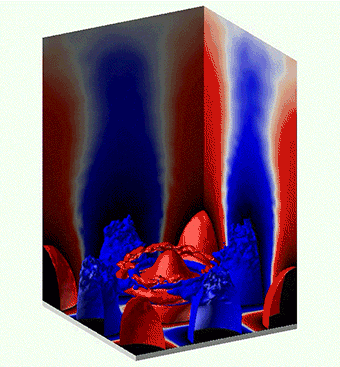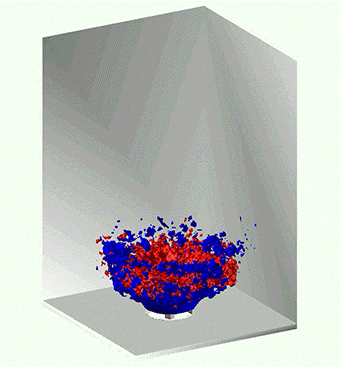DMD modes of the pressure. Credit: Tokyo Institute of Technology
Intensive pressure oscillations by thermoacoustic instabilities are critical for the operation of practical gas turbine combustors. However, it is difficult to investigate interactions between turbulent flames and acoustic modes of combustors due to the existence of complex dynamics and their three-dimensional nature.
Now, Kozo Aoki, Masayasu Shimura, Mamoru Tanahashi and colleagues at Tokyo Institute of Technology have shown that turbulent flame fluctuations induced by large- and fine-scale vortical motions interact with specific three-dimensional acoustic modes of a combustor.
The characteristics were investigated by applying dynamic mode decomposition (DMD) to results of direct numerical simulations (DNS) of turbulent swirling premixed flames in a small cuboid combustor. The transverse acoustic plane waves and pressure oscillations induced by large-scale vortical motions play important roles for pressure oscillations in the combustor.
DMD of heat release rate field reveals that the DMD modes of pressure with high amplitude do not necessarily have coupling with fluctuations of heat release rate, whereas oscillation modes caused by large-scale vortical motions have large energy not only in pressure field but also in heat release rate field.
These results indicate the significance of the control of large-scale vortical motion to suppress thermoacoustic instability. Furthermore, thermoacoustic instability has been investigated recently from the view point of disturbance energy, which will contribute to deepen understanding of the mechanisms of thermoacoustic instability.
Heat release rate fields at 124 kHz. Credit: Tokyo Institute of Technology
More information: Kozo Aoki et al. Short- and long-term dynamic modes of turbulent swirling premixed flame in a cuboid combustor, Proceedings of the Combustion Institute (2015). DOI: 10.1016/j.proci.2014.10.003
Kozo Aoki et al. Disturbance energy budget of turbulent swirling premixed flame in a cuboid combustor, Proceedings of the Combustion Institute (2017). DOI: 10.1016/j.proci.2016.08.033
Provided by Tokyo Institute of Technology
























